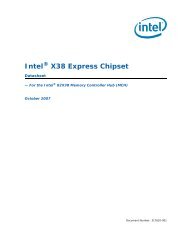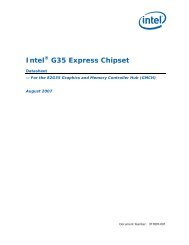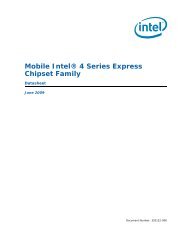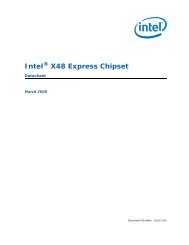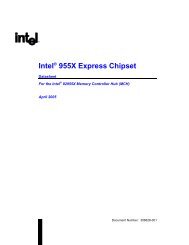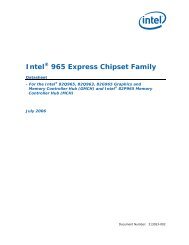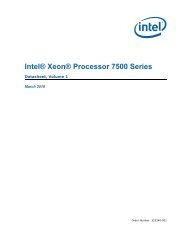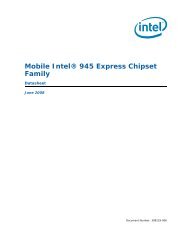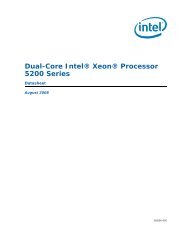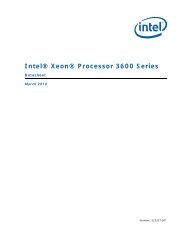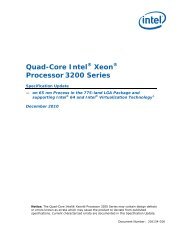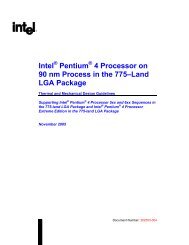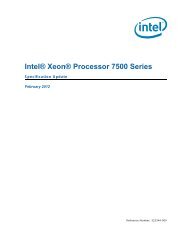Intel® 945G/945GZ/945GC/ 945P/945PL Express Chipset Family ...
Intel® 945G/945GZ/945GC/ 945P/945PL Express Chipset Family ...
Intel® 945G/945GZ/945GC/ 945P/945PL Express Chipset Family ...
You also want an ePaper? Increase the reach of your titles
YUMPU automatically turns print PDFs into web optimized ePapers that Google loves.
Functional Description<br />
10.5.8.3 Advanced Deinterlacing and Dynamic Bob and Weave<br />
10.5.9 Pipes<br />
Interlaced data that originates from a video camera creates two fields that are temporally offset by<br />
1/60 of a second. There are several schemes to deinterlace the video stream: line replication,<br />
vertical filtering, field merging, and vertical temporal filtering. Field merging takes lines from the<br />
previous field and inserts them into the current field to construct the frame – this is known as<br />
Weaving. This is the best solution for images with little motion; however, showing a frame that<br />
consists of the two fields will have serration or feathering of moving edges when there is motion<br />
in the scene. Vertical filtering or “Bob” interpolates adjacent lines rather replicating the nearest<br />
neighbor. This is the best solution for images with motion; however, it will have reduced spatial<br />
resolution in areas that have no motion and introduces jaggies. In absence of any other<br />
deinterlacing, these form the baseline and are supported by the GMCH.<br />
Scaling Filter and Control<br />
The scaling filter has three vertical taps and five horizontal taps. Arbitrary scaling (per pixel<br />
granularity) for any video source (YUV422 or YUV420) format is supported.<br />
The overlay logic can scale an input image up to 1600X1200 with no major degradation in the<br />
filter used as long as the maximum frequency limitation is met. Display resolution and refresh rate<br />
combinations where the dot clock is greater than the maximum frequency require the overlay to<br />
use pixel replication.<br />
The display consists of two pipes. The pipes can operate in a single-wide or “double-wide” mode<br />
at 2x graphics core clock though they are effectively limited by the respective display port. The<br />
display planes and the cursor plane will provide a “double wide” mode to feed the pipe.<br />
10.5.9.1 Clock Generator Units (DPLL)<br />
The clock generator units provide a stable frequency for driving display devices. It operates by<br />
converting an input reference frequency into an output frequency. The timing generators take<br />
their input from internal DPLL devices that are programmable to generate pixel clocks in the<br />
range of 25–400 MHz. Accuracy for VESA timing modes is required to be within ±0.5%.<br />
The DPLL can take a reference frequency from the external reference input (DREFCLKN/P) or<br />
the TV clock input (SDVO_TVCLKIN+/-).<br />
10.6 Display Interfaces (Intel ® 82<strong>945G</strong>/82<strong>945G</strong>C/82<strong>945G</strong>Z<br />
GMCH Only)<br />
The GMCH has three display ports; one analog and two digital. Each port can transmit data<br />
according to one or more protocols. The digital ports are connected to an external device that<br />
converts one protocol to another. Examples of this are TV encoders, external DACs, LVDS<br />
transmitters, and TMDS transmitters. Each display port has control signals that may be used to<br />
control, configure, and/or determine the capabilities of an external device.<br />
The GMCH has one dedicated display port; the analog port. SDVO ports B and C are multiplexed<br />
with the PCI <strong>Express</strong> graphics interface and are not available if an external PCI <strong>Express</strong> graphics<br />
252



